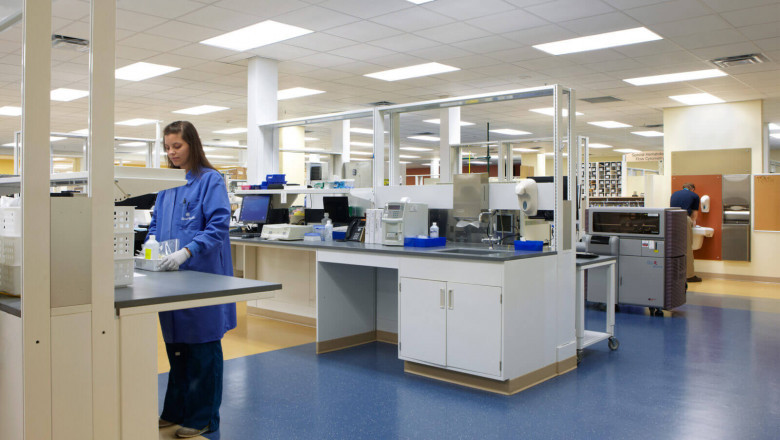views
healthcare is undergoing a digital transformation, with technology helping improve access, lower costs, and enhance quality of care. This revolution is also impacting medical laboratories, which play a crucial role in disease diagnosis, treatment management and prevention. With patients increasingly seeking convenient virtual care options, healthcare providers require lab testing solutions that can seamlessly integrate into digital workflows.
Moving Lab Testing to Large, Automated Facilities
Traditionally, most Central Lab have been small, local facilities serving individual hospitals, clinics or physician practices. However, this model faces challenges in terms of operating efficiencies, quality control and adapting to new technologies. Over the past decade, there has been a shift towards larger, centralized laboratories that utilize automation, robotics, and information systems to process thousands of samples daily. Known as "reference labs" or "regional labs", these centralized facilities achieve economies of scale by consolidating testing volumes from multiple client organizations into high-throughput systems.
The use of automation allows centralized labs to standardize procedures, minimize manual errors and augment staff capabilities. Robotic instruments can handle repetitive tasks like loading samples onto analyzers or sorting test results. Digital tools also enable centralization of administrative functions like test ordering, result delivery and billing. By aggregating testing needs from a wide service area, centralized labs maximize asset utilization to fully leverage their capital investments in advanced technologies. This ultimately reduces per-test costs compared to smaller, decentralized labs.
Quality is another key advantage of centralized labs. Large volumes provide opportunities for staff to gain deep expertise through repetition of standardized processes. Strict quality control practices are enforced through systems that electronically monitor equipment performance, validate test outcomes and identify errors. Centralized labs are also well-positioned to rapidly adopt new technologies and specialized tests as they emerge compared to smaller labs with more limited budgets. Overall, centralization supports higher quality and more reliable testing services for healthcare providers and patients.
Birth of the Lab Operator
The centralized lab model has realized such significant benefits that some lab companies have taken aggregation to the next level - operating networks of regional labs spanning multiple countries. Known as " labs", these operators process sample volumes from worldwide locations through a coordinated system of laboratories in strategically located hubs. lab MedLabs is one prominent example, with a network of facilities across Asia, Africa, Europe and the Americas.
The approach amplifies many of the efficiencies and quality advantages of centralized labs. Being multi-national enables optimal routing of samples based on test type, turnaround time requirements and laboratory capacity. It also facilitates 24/7 testing through coordinated hand-offs between labs in different time zones. Larger scale affords further opportunities to standardize procedures and leverage automation on a scale.
Perhaps the greatest value, however, lies in consistent quality wherever clients are located. Regardless of which MedLabs facility actually analyzes a sample, the operating system ensures it receives the same rigorous quality controls and access to the highest testing technologies. Customers benefit from seamless, reliable service comparable to a single large lab - but with vastly wider geographic coverage. This model is especially compelling for multinational companies needing ly integrated testing for employees, clinical trials or research projects spanning multiple countries.
The Rise of Digital Integration
Along with centralized operations, digital transformation is the other big driver behind the emergence of lab companies. Advanced IT systems enable coordination of sample management, testing and result delivery across a vast enterprise. Digital tools also facilitate seamless integration between the lab network and client healthcare IT systems through application programming interfaces (APIs) and interoperability standards.
This level of digital connectivity opens up new possibilities. For example, labs can directly transmit test orders and results into electronic health records (EHRs) and physician practice management systems without manual entry. Automated interfaces minimize data entry errors and support rapid test turnaround. Digital tools are also key for telehealth and remote patient monitoring applications needing lab data connections.
Perhaps most importantly, digital platforms empower patient-centered care models by giving individuals easy access to their lab results. Clients of MedLabs can retrieve test reports through a mobile app for tracking health trends over time. Physicians gain real-time access to test data within their EHR workflows, enabling well-informed treatment decisions regardless of patient location during travel. Comprehensive digital tools are elevating labs beyond traditional testing facilities into strategic partners supporting healthcare delivery transformation.
The Future of Lab Medicine is
lab networks like MedLabs are well-positioned to shape the future of healthcare as it becomes increasingly digital, patient-centered and data-driven across borders. With their combination of centralized operations, automation, quality management rigor and digital connectivity spanning multinational settings, these advanced lab providers deliver unparalleled value. They fulfill growing demands from both healthcare organizations and individuals for convenient, reliable testing integrated seamlessly into care wherever patients live, work or travel internationally.
As population health systems aim to proactively support wellness and disease prevention on a scale using real-world clinical data, reference labs will play an invaluable role. Their aggregated worldwide test volume and digital platforms create opportunities for advanced analytics, novel diagnostic applications through things like genomic and molecular testing, and coordinated disease surveillance across continents. The coming years will likely see even tighter integration of these strategic laboratory networks within technology-empowered, data-fueled transformation of healthcare delivery and research. The future of lab medicine is .
Get this Report in Japanese Language:
Get this Report in Korean Language:
About Author:
Money Singh is a seasoned content writer with over four years of experience in the market research sector. Her expertise spans various industries, including food and beverages, biotechnology, chemical and materials, defense and aerospace, consumer goods, etc. (https://www.linkedin.com/in/money-singh-590844163)






















Comments
0 comment